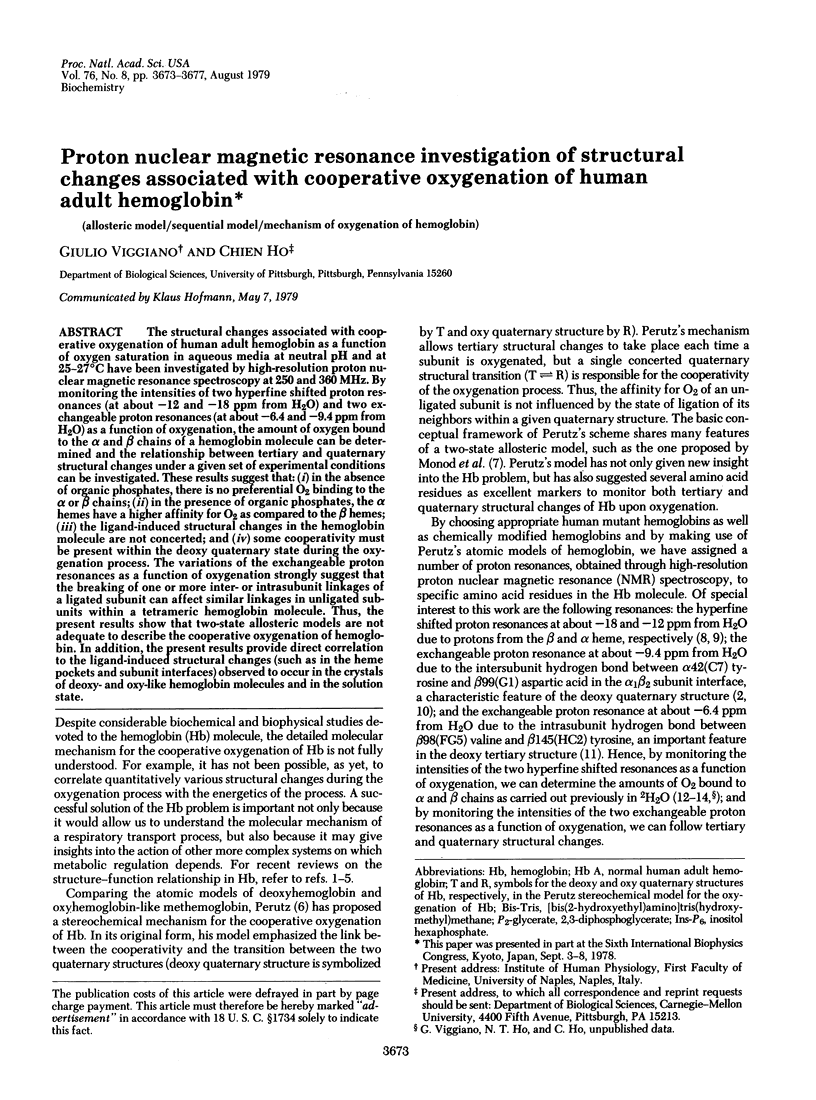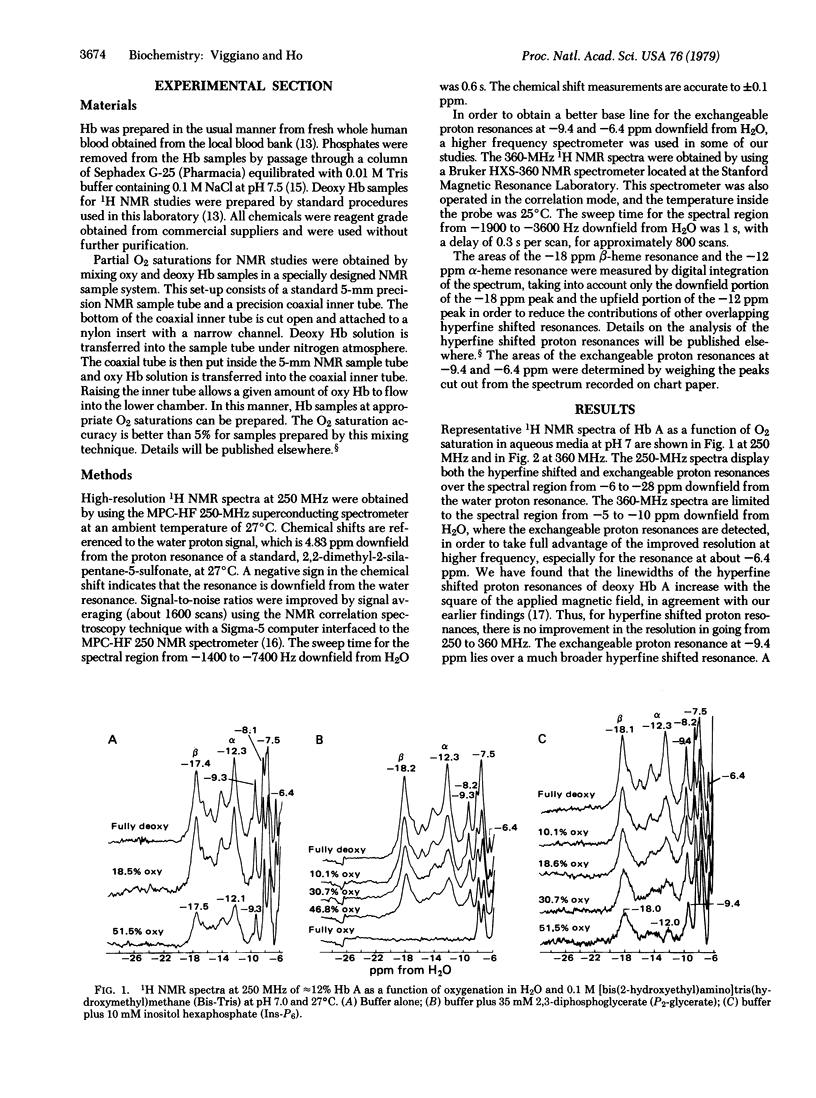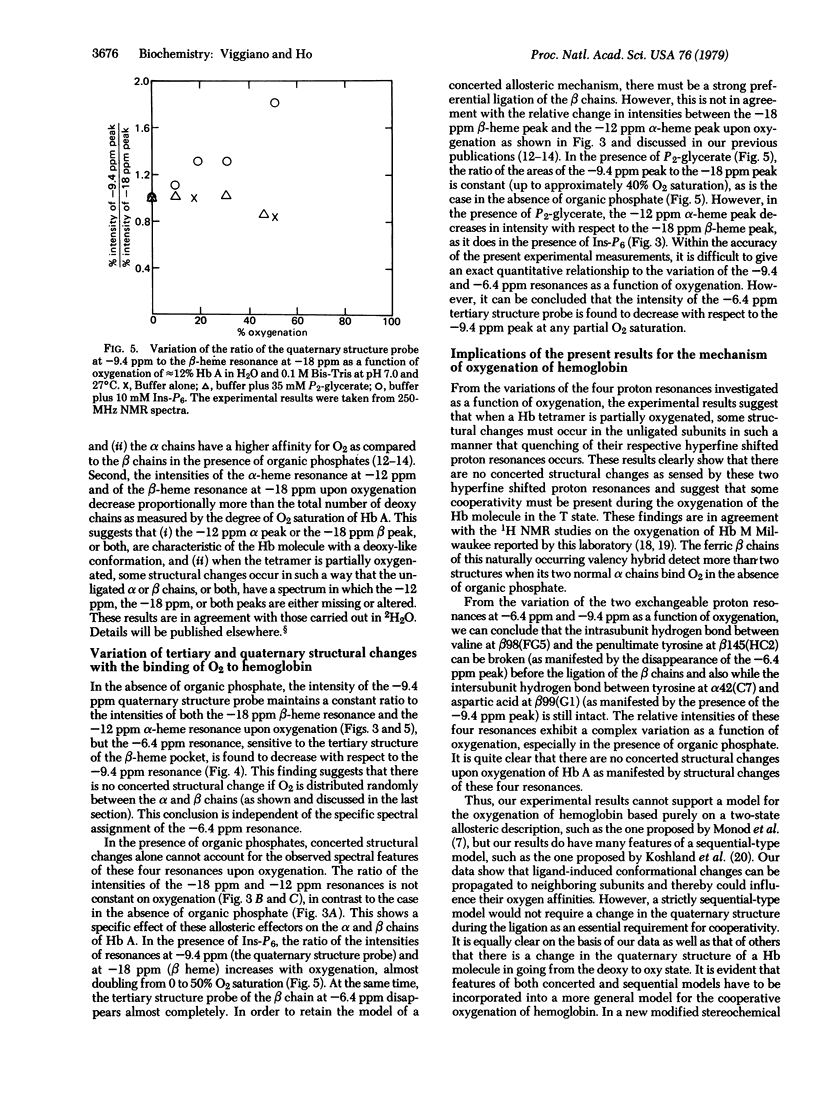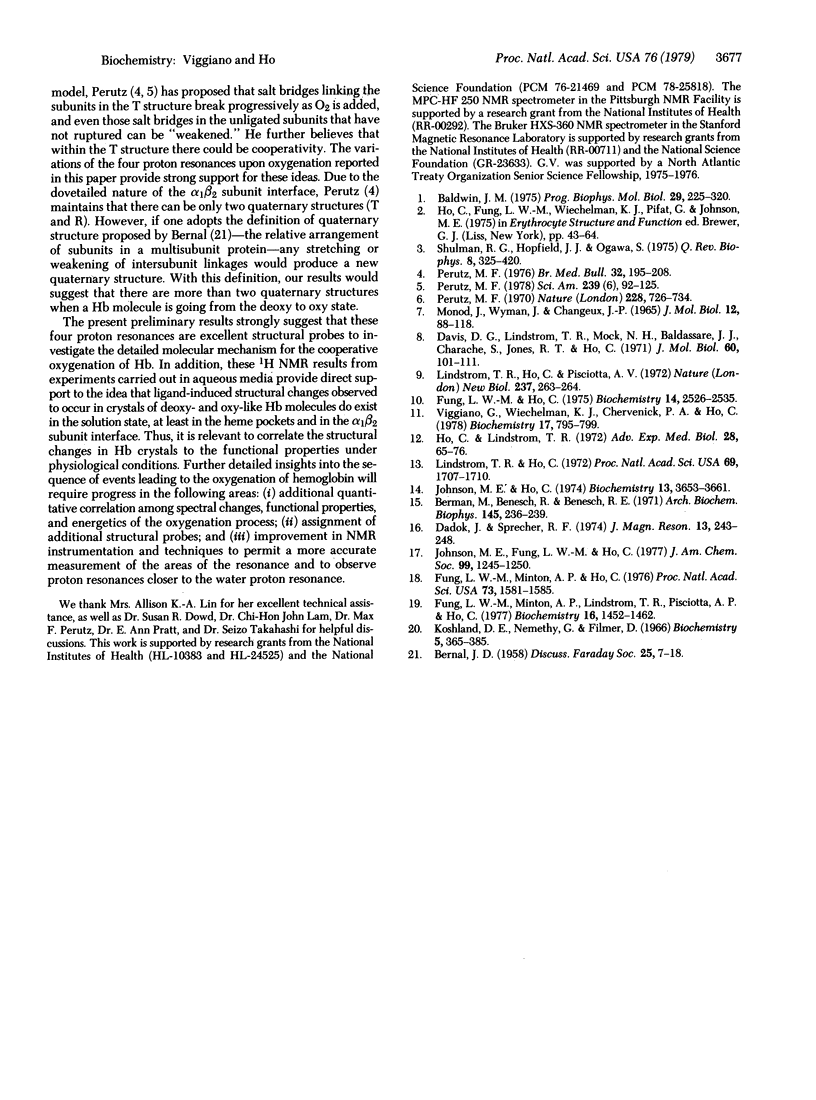Abstract
The structural changes associated with cooperative oxygenation of human adult hemoglobin as a function of oxygen saturation in aqueous media at neutral pH and at 25-27°C have been investigated by high-resolution proton nuclear magnetic resonance spectroscopy at 250 and 360 MHz. By monitoring the intensities of two hyperfine shifted proton resonances (at about -12 and -18 ppm from H2O) and two exchangeable proton resonances (at about -6.4 and -9.4 ppm from H2O) as a function of oxygenation, the amount of oxygen bound to the α and β chains of a hemoglobin molecule can be determined and the relationship between tertiary and quaternary structural changes under a given set of experimental conditions can be investigated. These results suggest that: (i) in the absence of organic phosphates, there is no preferential O2 binding to the α or β chains; (ii) in the presence of organic phosphates, the α hemes have a higher affinity for O2 as compared to the β hemes; (iii) the ligand-induced structural changes in the hemoglobin molecule are not concerted; and (iv) some cooperativity must be present within the deoxy quaternary state during the oxygenation process. The variations of the exchangeable proton resonances as a function of oxygenation strongly suggest that the breaking of one or more inter- or intrasubunit linkages of a ligated subunit can affect similar linkages in unligated subunits within a tetrameric hemoglobin molecule. Thus, the present results show that two-state allosteric models are not adequate to describe the cooperative oxygenation of hemoglobin. In addition, the present results provide direct correlation to the ligand-induced structural changes (such as in the heme pockets and subunit interfaces) observed to occur in the crystals of deoxy- and oxy-like hemoglobin molecules and in the solution state.
Keywords: allosteric model, sequential model, mechanism of oxygenation of hemoglobin
Full text
PDF




Selected References
These references are in PubMed. This may not be the complete list of references from this article.
- Baldwin J. M. Structure and function of haemoglobin. Prog Biophys Mol Biol. 1975;29(3):225–320. doi: 10.1016/0079-6107(76)90024-9. [DOI] [PubMed] [Google Scholar]
- Berman M., Benesch R., Benesch R. E. The removal of organic phosphates from hemoglobin. Arch Biochem Biophys. 1971 Jul;145(1):236–239. doi: 10.1016/0003-9861(71)90031-2. [DOI] [PubMed] [Google Scholar]
- Davis D. G., Lindstrom T. R., Mock N. H., Baldassare J. J., Charache S., Jones R. T., Ho C. Nuclear magnetic resonance studies of hemoglobins. VI. Heme proton spectra of human deoxyhemoglobins and their relevance to the nature of co-operative oxygenation of hemoglobin. J Mol Biol. 1971 Aug 28;60(1):101–111. doi: 10.1016/0022-2836(71)90450-5. [DOI] [PubMed] [Google Scholar]
- Fung L. W., Ho C. A proton nuclear magnetic resonance study of the quaternary structure of human homoglobins in water. Biochemistry. 1975 Jun 3;14(11):2526–2535. doi: 10.1021/bi00682a036. [DOI] [PubMed] [Google Scholar]
- Fung L. W., Minton A. P., Ho C. Nuclear magnetic resonance study of heme-heme interaction in hemoglobin M Milwaukee: implications concerning the mechanism of cooperative ligand binding in normal hemoglobin. Proc Natl Acad Sci U S A. 1976 May;73(5):1581–1585. doi: 10.1073/pnas.73.5.1581. [DOI] [PMC free article] [PubMed] [Google Scholar]
- Fung L. W., Minton A. P., Lindstrom T. R., Pisciotta A. V., Ho C. Proton nuclear magnetic resonance studies of hemoglobin M Milwaukee and their implications concerning the mechanism of cooperative oxygenation of hemoglobin. Biochemistry. 1977 Apr 5;16(7):1452–1462. doi: 10.1021/bi00626a033. [DOI] [PubMed] [Google Scholar]
- Ho C., Lindstrom T. R. Functional non-equivalence of and hemes in human hemoglobins. Adv Exp Med Biol. 1972;28:65–76. doi: 10.1007/978-1-4684-3222-0_5. [DOI] [PubMed] [Google Scholar]
- Johnson M. E., Fung L. W., Ho C. Magnetic field and temperature induced line broadening in the hyperfine-shifted proton resonances of myoglobin and hemoglobin. J Am Chem Soc. 1977 Feb 16;99(4):1245–1250. doi: 10.1021/ja00446a041. [DOI] [PubMed] [Google Scholar]
- Johnson M. E., Ho C. Effects of ligands and organic phosphates on functional properties of human adult hemoglobin. Biochemistry. 1974 Aug 27;13(18):3653–3661. doi: 10.1021/bi00715a005. [DOI] [PubMed] [Google Scholar]
- Koshland D. E., Jr, Némethy G., Filmer D. Comparison of experimental binding data and theoretical models in proteins containing subunits. Biochemistry. 1966 Jan;5(1):365–385. doi: 10.1021/bi00865a047. [DOI] [PubMed] [Google Scholar]
- Lindstrom T. R., Ho C. Functional nonequivalence of and hemes in human adult hemoglobin. Proc Natl Acad Sci U S A. 1972 Jul;69(7):1707–1710. doi: 10.1073/pnas.69.7.1707. [DOI] [PMC free article] [PubMed] [Google Scholar]
- Lindstrom T. R., Ho C., Pisciotta A. V. Nuclear magnetic resonance studies of haemoglobin M Milwaukee. Nat New Biol. 1972 Jun 28;237(78):263–264. doi: 10.1038/newbio237263a0. [DOI] [PubMed] [Google Scholar]
- MONOD J., WYMAN J., CHANGEUX J. P. ON THE NATURE OF ALLOSTERIC TRANSITIONS: A PLAUSIBLE MODEL. J Mol Biol. 1965 May;12:88–118. doi: 10.1016/s0022-2836(65)80285-6. [DOI] [PubMed] [Google Scholar]
- Perutz M. F. Hemoglobin structure and respiratory transport. Sci Am. 1978 Dec;239(6):92–125. doi: 10.1038/scientificamerican1278-92. [DOI] [PubMed] [Google Scholar]
- Perutz M. F. Stereochemistry of cooperative effects in haemoglobin. Nature. 1970 Nov 21;228(5273):726–739. doi: 10.1038/228726a0. [DOI] [PubMed] [Google Scholar]
- Perutz M. F. Structure and mechanism of haemoglobin. Br Med Bull. 1976 Sep;32(3):195–208. doi: 10.1093/oxfordjournals.bmb.a071363. [DOI] [PubMed] [Google Scholar]
- Shulman R. G., Hopfield J. J., Ogawa S. Allosteric interpretation of haemoglobin properties. Q Rev Biophys. 1975 Jul;8(3):325–420. doi: 10.1017/s0033583500001840. [DOI] [PubMed] [Google Scholar]
- Viggiano G., Wiechelman K. J., Chervenick P. A., Ho C. Proton nuclear magnetic resonance studies of hemoglobins Osler (beta145HC2 Tyr replaced by Asp) and McKee Rocks (beta145HC2 Tyr replaced by term): an assignment for an important tertiary structural probe in hemoglobin. Biochemistry. 1978 Mar 7;17(5):795–799. doi: 10.1021/bi00598a007. [DOI] [PubMed] [Google Scholar]


